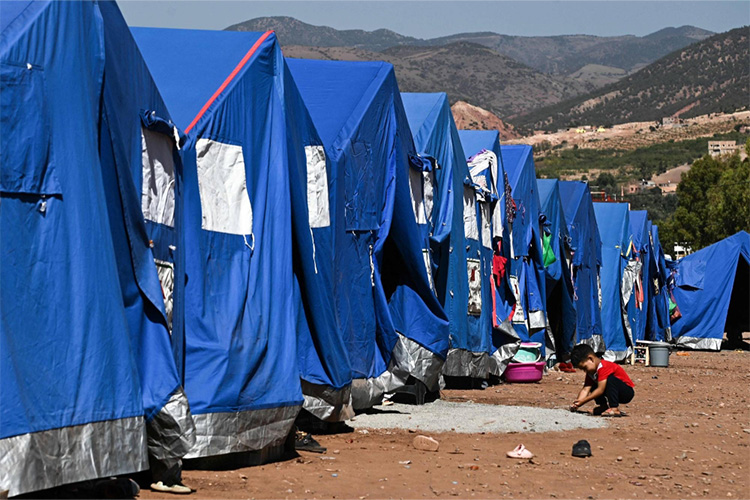
Relief tents were constructed near a military field hospital to help those injured by the earthquake in the village of Asni located in the High Atlas Mountains. photo courtesy of Philippe Lopez
The recent earthquake in west Morocco has killed and injured thousands of civilians.
On September 8th, residents of western Morocco awoke to the booming vibrations of a 6.8 magnitude earthquake. The quake struck around 11:11 p.m. 50 miles southwest of the city of Marrakesh, forcing citizens to evacuate their crumbling homes into debris-ridden streets. The greatest devastation caused by the seismic activity was subject to Marrakesh, as well as communities south of the metropolis. The death toll currently rests at 2,900, according to Morocco’s Interior Minister.
The following day, Morocco’s King, Mohammed VI, proclaimed a three-day period of national mourning. In addition, the Moroccan royal palace ordered civil protection units to increase access to blood banks, clean water, food, tents, and blankets. However, many of the impacted areas were remote, making them difficult to reach in the hours following the disaster. Morocco also accepted offers from the Netherlands and United Kingdom to deploy emergency response teams composed of rescue specialists, medical teams, search dogs, and relief equipment. Despite immense rescue efforts, those in rural villages have continued to dig via hand and shovel to find their loved ones.
The quake initially struck near the town of Oukaimeden in the Atlas Mountains. Thousands of civilians living in traditional, native homes in the mountains were hit the hardest. The topography of the Atlas Mountains has posed a huge obstacle for rescue teams attempting to import heavy digging equipment. These small mountain roads are littered with sharp curves and an absence of guardrails, making it difficult for journalists and aid trucks to pass through. The town of Asimsiz, resting in an Atlas mountain valley 34 miles south of Marrakesh, was subject to some of the earthquake’s worst effects. The tremors led officials to declare the local hospital as unsafe to enter. Due to the hospital’s instability, residents of Asimsiz are being treated in tents near the facility. In an article published by BBC, writers Alice Cuddy and Graeme Baker reveal that “A hospital official, who asked not to be named, said that around 100 bodies were brought [to the tents] on Saturday.” The same official was quoted, saying “I was crying because there were so many dead people, especially the young children. Since the earthquake I haven’t slept. None of us have.” As medical experts rush to save lives, scientists across the globe focus their efforts on determining the cause of the earthquake.
After observing the country’s geologic history, it is evident that a 6.8 magnitude earthquake is quite extraordinary for Morocco. The United States Geological Survey claims, “there have been no recorded earthquakes of M6 or larger within 500 km of this event [in over 120 years].” Seismic activity comparable to this historic earthquake is far more common in northern Morocco near the Mediterranean Sea. This begs the question: what caused this devastating earthquake?
Researchers deduced that the quake was caused by the African tectonic plate slowly crushing up against the Eurasian plate. This seismic activity has been happening slowly for roughly the last 60 million years. The quake in Morocco was the result of the two plates producing what is known as a reverse fault. This occurs when one tectonic plate pushes and forces another plate to rise above ground level. Mountain ranges, such as the High Atlas Mountains, are especially prone to reverse faulting, which explains why this earthquake was so severe. However, when interviewed by the Washington Post, earthquake geologist Wendy Bohon clarified that “earthquakes don’t kill people…buildings kill people.”
Many of the homes native to the Atlas Mountains were constructed using ancient building techniques such as mud work and masonry. Families in these rural communities tend to build these structures themselves using stone, wood, and raw earth. Many of these homes fell victim to this month’s earthquake. Conversely, more affluent and effectively prepared places around the globe utilize reinforced concrete, helping them sustain only moderate damage under the force of an earthquake.
The destruction caused by this earthquake is devastating, but also serves as a lesson for countries to implement better emergency response services in case of a geological crisis. If you or somebody you know would like to support the victims of this crisis, please consider donating to UNICEF or the Red Cross, both of which strive to prevent human suffering in every corner of the world.